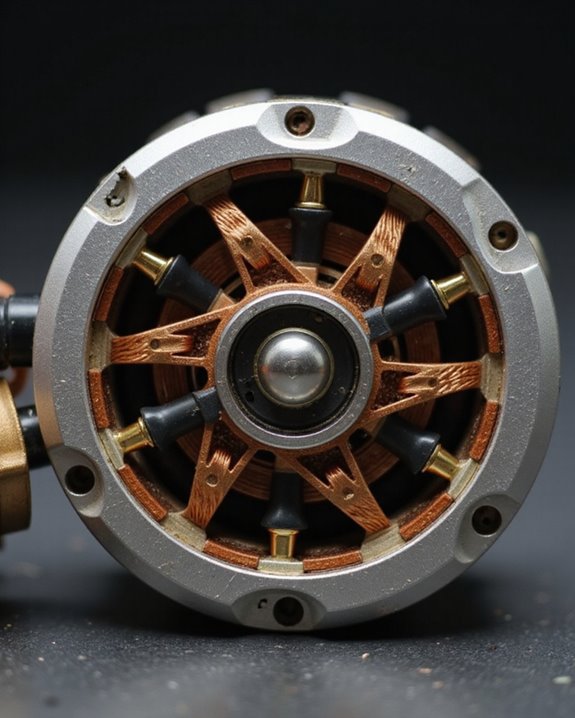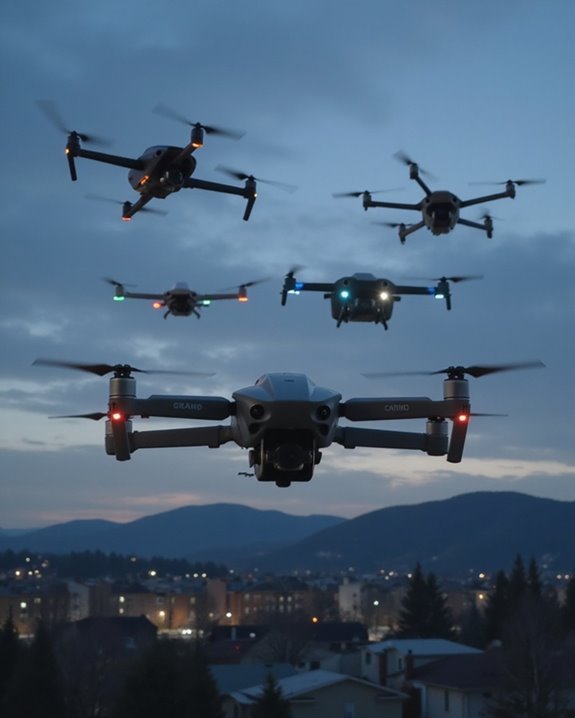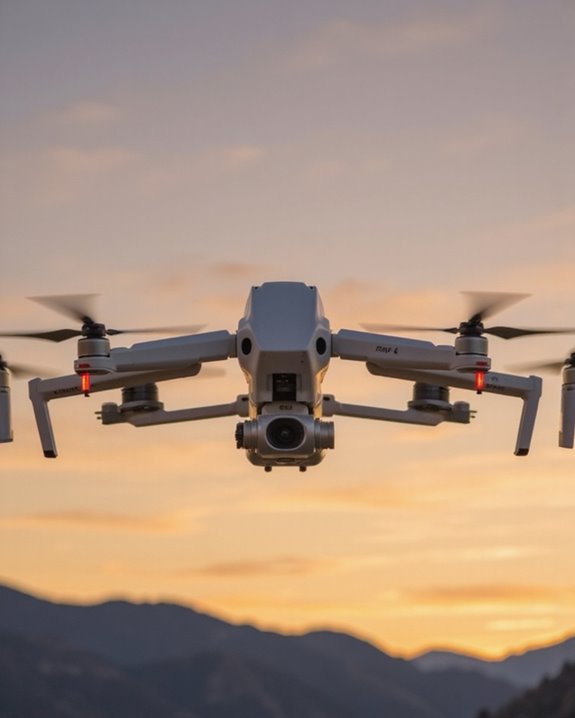You’ll find your perfect drone motor match among three impressive options! The compact 8520 brushed motor excels for mini builds with its high RPM output, while the beastly XOAR Titan T8120 lifts an incredible 47.2kg for heavy-duty applications. For versatile mid-range builds, the Readytosky 2212 920KV delivers reliable 580g thrust with smooth operation. Each motor brings unique strengths to your build, and choosing the right one comes down to understanding your specific needs.
Key Takeaways
- XOAR Titan T8120 is optimal for heavy-duty applications, supporting up to 47.2kg lift capacity for octocopters with 100KV configuration.
- Readytosky 2212 motors provide reliable performance for F450/F550 frames with 580g thrust and excellent heat management.
- 8520 brushed motors suit mini quadcopters, offering durable construction and high RPM output at 5V with pre-wired installation.
- Each motor type serves different purposes: XOAR for industrial/filming, Readytosky for mid-range builds, 8520 for mini projects.
- Consider KV ratings, frame compatibility, and power requirements when choosing between these three motor options for your drone.
4pcs 8520 Brushed Motors with Propellers for RC Quadcopter
- 8520 Brushed Motor Diameter: 8.5mm; Motor Length: 20mm; Cable Length: 80mm,With 1.25mm JST Plug
- 15000KV 8520 Brushed Motor: Operating Voltage: 3-5V; Speed: 31,500 RPM with 3V Voltage; 53,000 RPM with 5V Voltage
- High Quality: 8520 Brushed Motor Made of High Quality Material, Small Size, Large Torque, Smooth Operation, High Efficiency, Low Noise, Stable Support
Hobbyist drone builders and RC enthusiasts will find the 8520 brushed motors perfect for their mini quadcopter projects! These compact powerhouses measure just 8.5mm in diameter and pack impressive performance specs – reaching up to 53,000 RPM at 5V.
You’ll love how these motors connect easily with their 1.25mm JST plugs, featuring CW red/blue and CCW black/white wiring configurations. They’re compatible with popular frames like the Tiny 8X and DJI Ryze Tello, plus they’re built tough enough to handle those inevitable crashes. While some users note they’re smaller than expected, their durability and budget-friendly price make them ideal replacement motors when you’re learning the ropes!
Best For: RC hobbyists and drone builders looking for affordable, compact motors for mini quadcopter projects, particularly those working with Tiny 8X frames or DJI Ryze Tello builds.
Pros:
- High performance specs with impressive RPM range (31,500-53,000)
- Easy installation with pre-wired JST plugs and clear polarity marking
- Durable construction that can withstand crashes while remaining cost-effective to replace
Cons:
- Smaller physical size than some users expect
- Some packages missing connection pieces
- Dimensional specifications may be slightly inaccurate from listing
XOAR Titan T8120 Brushless Electric Motor for RC Drones
- INTRODUCING XOAR TITAN HEAVY LIFTING SERIES: XOAR Titan Heavy Lifting Series offers all multicopters and drones manufacturers, engineers, pilots and enthusiasts the best...
- BEST PROPULSION SYSTEM: XOAR Titan T8120 Brushless Electric Motors are specially designed with top grade materials and tested for dynamic balance. XOAR Titan's light...
- ALL UP WEIGHT (AUW): For quadcopter, hexacopter, octocopter from min. 10.4 Kg, 15.6 Kg, 20.8 Kg to max. 23.6 Kg, 35.4 Kg and 47.2 Kg respectively.
Professional drone operators seeking maximum lift capacity will find their perfect match in the XOAR Titan T8120 Brushless Electric Motor. This powerhouse can handle impressive payloads – up to 23.6 kg for quadcopters, 35.4 kg for hexacopters, and a whopping 47.2 kg for octocopters! You’ll love its precision-engineered design featuring a 20mm shaft diameter and perfectly balanced construction.
The T8120’s 100KV configuration and 36N40P setup deliver smooth, reliable performance that’ll keep your heavy-lift drone running like a dream. When paired with XOAR’s recommended propellers, from the 26×9.2 to the mighty 34×14, you’re getting a motor that’s ready to tackle your most demanding aerial projects.
Best For: Professional drone operators and commercial users requiring heavy-lift capabilities for industrial, filming, or specialized cargo applications.
Pros:
- Exceptional lift capacity, supporting up to 47.2kg with octocopter configurations
- High-quality construction with precision balancing for smooth, reliable performance
- Versatile compatibility with multiple XOAR propeller sizes for different applications
Cons:
- Relatively high weight at 556g may impact overall drone efficiency
- Premium price point typical of professional-grade heavy-lift motors
- Limited to specialized heavy-lift applications, overkill for standard consumer drone use
Readytosky 2212 920KV Brushless Motors for Quadcopter (4-Pack)
- ★This Motors are less noise and stable.
- ★With 3.5mm bullet conenctors,save welding trouble.
- ★Fit for F330 F450 F550 S500 S550 Quadcopter.
The Readytosky 2212 920KV Brushless Motors pack delivers reliable power for DIY drone builders who want a proven motor setup without breaking the bank! You’ll find these motors right at home on popular frames like the F450, F550, and even DJI Phantom builds, where they’ll spin your 1045 props with impressive thrust.
Performance testing shows these workhorses can push up to 580g of thrust at full power, and they’ll run cool even after extended flights. While you might need to drill your props and deal with some occasional quality quirks, the durable construction and smooth bearings make these motors a solid choice for your next build!
Best For: Budget-conscious DIY drone builders looking for reliable motors to power medium-sized quadcopter frames like F450, F550, and DJI Phantom clones.
Pros:
- Impressive thrust capability up to 580g with good heat management during extended use
- Compatible with popular drone frames and affordable for a complete 4-motor set
- Durable construction with smooth bearings that can survive crashes
Cons:
- Some quality control issues with occasional DOA motors or unbalanced bells
- Props may require drilling for proper mounting
- No mounting screws included in the package
Factors to Consider When Choosing a Drone Motor

When you’re ready to select the perfect motor for your drone, you’ll need to weigh several critical factors that’ll make or break your flying experience! The essential elements include matching the motor’s size and weight to your frame, understanding power requirements and voltage ranges, and considering the all-important KV rating that determines your prop speed. You’ll also want to evaluate the thrust-to-weight ratio for ideal lift performance and check those noise and vibration specs – because nobody wants their drone sounding like a blender having a meltdown!
Motor Size and Weight
Selecting ideal motor size and weight ranks among your most important decisions when building a drone that’ll perform exactly as you need it to!
You’ll want to match your motor’s dimensions to your drone’s specific purpose. For micro-drones that need to zip through tight spaces, motors under 10mm in diameter are your best friends – they’re like the sports cars of the drone world! Heavier motors, around 500 grams, are perfect when you need serious lifting power for camera equipment or weathering those gusty days. Remember, your motor’s size and weight directly impact your drone’s center of gravity, which is essential for those smooth, stable flights you’re after. The sweet spot lies in finding that perfect balance between power and efficiency – too heavy, and you’ll drain your battery faster than a smartphone at a selfie convention!
Power and Voltage Range
Power and voltage specifications stand as critical factors that’ll make or break your drone’s performance! When you’re selecting a motor, you’ll need to understand how voltage and current work together to produce watts – that’s your raw power output right there.
Your motor’s voltage range is like its comfort zone, typically spanning from 3V to 12V. Want to geek out on some numbers? At 5V, you’re looking at speeds up to 53,000 RPM – now that’s zippy! The KV rating is your best friend here, telling you exactly how many RPMs you’ll get per volt. Remember, staying within the recommended voltage range isn’t just about playing it safe; it’s about squeezing out maximum efficiency. Going from 3V to 5V can boost your RPMs from 31,500 to 53,000, giving your drone that extra oomph you’re looking for!
KV Rating Impact
Have you ever wondered why some drone motors spin like crazy while others take it slow and steady? It all comes down to the KV rating, which tells you exactly how many RPMs you’ll get per volt!
When you’re choosing a motor, higher KV ratings will give you that zippy, race-ready performance – perfect if you’re looking to zoom through the sky. But don’t get too excited about those high numbers just yet. They’ll drain your battery faster than a thirsty camel in the desert! Lower KV motors, on the other hand, are your go-to for heavy lifting and smooth aerial photography. They’re like the trusty workhorses of the drone world, offering better torque and stability when you need it most.
Thrust to Weight Ratio
Beyond motor speed ratings, your drone’s lifting power tells an equally important story. The thrust to weight ratio is your key to unleashing impressive flight performance – you’ll want at least a 2:1 ratio for stable hovering and carrying capacity.
Think of it this way: if your drone weighs 500 grams, you’ll need motors that can each produce at least 250 grams of thrust to achieve that magical 2:1 ratio. While a 1:1 ratio might get you airborne (barely!), pushing beyond 3:1 opens up a whole new world of acrobatic possibilities. Your battery will thank you too, as higher ratios mean more efficient power usage during flight. When you’re selecting motors, check their thrust ratings carefully – they can range from 100 to 500+ grams, depending on your setup’s power and propeller configuration.
Noise and Vibration Levels
The peaceful hum of your drone can quickly turn into an irritating buzz if you don’t choose the right motors! You’ll want to pay special attention to noise and vibration levels, as they’re essential for both performance and your sanity during flight sessions.
When shopping for motors, look for brushless designs – they’re your best friends for quiet operation. You’ll definitely appreciate the difference when you’re not scaring away wildlife or disturbing the neighbors! Keep an eye out for motors with dynamic balancing features and high-quality bearings, as these components work together to minimize unwanted vibrations. While high-RPM motors (especially those running above 30,000) can get noisy, well-designed models with tight windings and proper balancing will help keep the decibels down. Remember, a smoother-running motor isn’t just quieter – it’s also more stable and efficient in flight!
Mounting and Installation Requirements
Proper motor mounting can make or break your drone’s performance, so let’s dive into the essential installation requirements you’ll need to evaluate!
First, you’ll want to match those mounting holes perfectly with your frame – there’s no room for a wobbly motor on your precious drone! Check the shaft diameter carefully, as a mismatched propeller hub will send your flight plans spinning. Don’t forget to examine the electrical connectors; you certainly don’t want to discover incompatible wiring when you’re ready for takeoff. Pay close attention to rotation direction too – your drone needs the right mix of clockwise and counterclockwise motors to stay balanced in the air. Finally, consider the motor’s weight and size specifications, because even the most powerful motor won’t help if it doesn’t fit your frame’s constraints!
Operating Temperature Limits
Understanding operating temperature limits can make the difference between a smooth-flying drone and a burnt-out disaster! You’ll want to keep your motor’s temperature between -20°C and 80°C for best performance – think of it as your drone’s comfort zone.
When you’re pushing your drone to its limits, keep in mind that different motors have different heat tolerances. Brushless motors are your best friend here, as they can handle slightly higher temperatures than their brushed cousins. Remember, just like you wouldn’t want to run a marathon in a sauna, your drone motor needs proper temperature management!
Watch out when operating at high power levels around 225W – you’ve got about a minute before things might get toasty. Keep these limits in mind, and your motor will thank you with consistently strong performance!
Propeller Compatibility Specifications
Selecting compatible propellers for your drone motor is like matchmaking for perfect flight performance! You’ll need to pay close attention to those KV ratings, as they’re essential for finding the sweet spot between speed and thrust that’ll make your drone sing through the air.
When you’re pairing props with your motor, don’t forget to check those shaft diameters – they need to fit together like two peas in a pod! Your propeller’s diameter and pitch must align with your motor’s voltage capabilities, or you’ll end up with an unhappy partnership that generates excess heat. Watch those thrust ratings too, as they’ll determine which propellers can handle your motor’s power without breaking a sweat. Remember, achieving proper balance between your motor and props isn’t just about performance – it’s about keeping those pesky vibrations at bay!
Frequently Asked Questions
How Long Do Drone Motors Typically Last Before Needing Replacement?
You’ll typically get 40-60 hours of flight time from quality drone motors before they need replacement, though this varies based on how you’re flying! With regular maintenance and gentle flying, you might stretch that to 100+ hours. However, if you’re doing aggressive maneuvers or flying in harsh conditions, your motors could wear out in just 20-30 hours. It’s smart to inspect them regularly and listen for any unusual noises or vibrations.
Can Drone Motors Be Repaired, or Must They Always Be Replaced?
Just like when your car needs a tune-up, drone motors can sometimes be repaired! You’ll find that basic issues like loose connections, worn brushes, or bearing problems are often fixable at home. However, if you’re dealing with burned-out windings or severe physical damage, replacement is your best bet. While repairs can save you money, they’re not always worth the time and effort – especially since new motors are relatively affordable these days.
What Causes Drone Motors to Overheat During Flight?
Your drone’s motors can overheat for several common reasons! Running your motors at full throttle for extended periods, pushing through heavy winds, or carrying loads that are too heavy can quickly raise temperatures. You’ll also face overheating if there’s poor airflow around your motors, they’re improperly sized for your drone, or you’re using incorrect propellers. Here’s a pro tip: give your drone brief “cool-down” breaks during intense flying sessions!
Are Drone Motors Water-Resistant or Waterproof?
Most drone motors aren’t naturally waterproof, but you’ll find that many are water-resistant! While some premium models come with an IPX5 or IPX6 rating for water resistance, you’ll want to be careful about flying in wet conditions. You can boost your motor’s protection by applying special waterproof coatings or conformal sprays, which form a protective barrier. Just remember – there’s a big difference between water-resistant and completely waterproof when it comes to your drone’s safety!
Do Weather Conditions Affect Drone Motor Performance and Lifespan?
Weather can hit your drone’s motors like a ton of bricks! Temperature, moisture, and wind greatly impact both performance and longevity. You’ll notice your motors working overtime in cold weather, which drains batteries faster, while extreme heat can strain internal components. Wind resistance forces your motors to push harder, and moisture’s your biggest enemy – it’ll corrode those bearings quicker than you can say “drone crash.” Keep an eye on those forecasts before taking flight!








